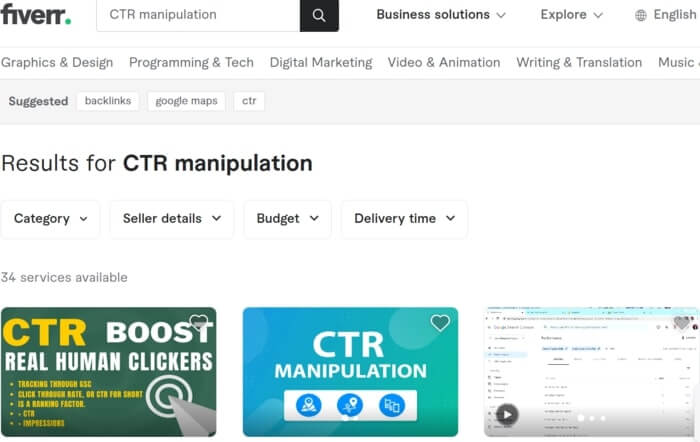Optimizing Organic Click-Through Rates With CTR Adjustment
The optimization of organic click-through rates (CTR) is a nuanced undertaking that rests on recognizing both user psychology and efficient web content presentation. By leveraging tactical adjustment strategies, such as powerfully crafted headlines and visually interesting aspects, online marketers can considerably improve user involvement. The landscape is raging with misunderstandings and oversimplifications concerning what really drives CTR. As we check out the intricacies of these strategies, it comes to be important to determine the underlying principles that can bring about sustained success in capturing target market interest. What truly sets apart the reliable from the ineffective in this critical aspect of electronic advertising and marketing?
Comprehending Click-Through Rates
Understanding click-through rates (CTR) is important for assessing the effectiveness of online marketing strategies. CTR determines the percent of individuals who click on a details web link or ad compared to the total variety of individuals that see it. A higher CTR shows that the web content is engaging and relevant to the target market, while a reduced CTR may signify a requirement for optimization.
To determine CTR, divide the number of clicks by the number of impacts and multiply by 100. For example, if an advertisement receives 300 clicks out of 10,000 impacts, the CTR would be 3%. This statistics is vital for evaluating various aspects of electronic advertising, including seo (SEO), e-mail campaigns, and social networks advertising.
Furthermore, analyzing CTR assists marketing professionals identify which methods yield the very best results and which call for refinement. By concentrating on improving CTR, services can boost their content's presence and efficacy, bring about increased web traffic and prospective conversions. Recognizing the nuances of CTR is foundational for any type of marketer intending to enhance their on-line presence and maximize roi (ROI)

The Psychology of User Actions
Customer habits is significantly affected by emotional aspects that dictate how individuals connect with online material. Comprehending these factors is important for optimizing click-through prices (CTR) in organic search results. Cognitive biases, such as the anchoring effect, play an essential role in forming individuals' perceptions. Their initial impacts can greatly influence their succeeding judgments regarding relevance and reputation. when individuals encounter details.
Emotional actions also substantially impact individual actions. Content that reverberates mentally can set off a feeling of necessity or curiosity, triggering customers to click. Additionally, social evidence-- such as customer evaluations or ratings-- can enhance depend on and urge engagement, as individuals usually look to the habits of others to inform their own choices.
In addition, the principle of scarcity can drive clicks - CTR Manipulation Press Release. Limited-time deals or unique web content create a worry of losing out (FOMO), engaging customers to act promptly. Understanding these psychological chauffeurs allows online marketers to produce even more engaging web content that resonates with their target audience
Reliable CTR Control Methods
Leveraging mental insights can significantly enhance click-through rates (CTR) through targeted manipulation methods. One of the most effective methods is using compelling headlines that stimulate interest or seriousness. Phrasing titles as concerns or incorporating numbers can attract more focus, motivating customers to click.
Another technique entails maximizing meta summaries to produce a sense of relevance and immediacy. By plainly describing the options or benefits offered in the content, you can involve possible visitors and persuade them to click. In addition, using power words-- such as "unique," "confirmed," or "complimentary"-- can enhance the charm of your web content.
Aesthetic aspects also play an essential function. Integrating eye-catching images or thumbnails can attract customers in and enhance CTR. A/B testing different visuals can help identify which photos resonate best with your audience.
Finally, guaranteeing that your material guarantees deliverable worth results in greater CTR. They are a lot more likely to engage when users regard that clicking will give them with meaningful insights or solutions. By using these techniques thoughtfully, online marketers can effectively manipulate CTR to their benefit while preserving moral standards.
Typical Myths About CTR
Numerous false impressions surround click-through rates (CTR) that can lead marketing experts to make misguided decisions. One common myth is that a higher CTR constantly translates to far better efficiency. While a high CTR suggests that even more users are clicking, it does not assure sales or conversions. Ultimately, the efficiency of traffic depends upon the high quality of the landing web page and the importance of the material.
An additional common idea is that CTR is a separated metric. Actually, CTR needs to be assessed along with various other performance signs, such as bounce price and conversion price, to acquire an alternative view of project success.
Furthermore, some marketers assume that optimizing for CTR alone suffices. Nonetheless, focusing exclusively on CTR can result in clickbait methods that might attract clicks but fall short to involve customers meaningfully. This approach can harm brand name credibility and lead to reduced retention rates
Last but not least, there is a notion that CTR strategies are generally effective. The fact is that optimum CTR techniques can vary substantially across sectors and target market, necessitating tailored approaches for various market segments. Recognizing these myths is crucial for developing effective CTR strategies that straighten with overarching marketing goals.
Gauging CTR Success
Although high click-through rates (CTR) can suggest successful involvement with web content, measuring their true success calls for an extensive evaluation of several elements. It is essential to comprehend the context in which the CTR is accomplished. For example, a high CTR on a deceptive title might not equate to significant involvement or conversions, inevitably reflecting improperly on Website the brand's reliability.
Second, examining the source of web traffic is essential. Organic traffic from search engines click here to read can represent a robust content strategy, while clicks from pointless resources might show an absence of targeting. In addition, gauging the succeeding customer actions is vital; analyzing metrics such as bounce rate, time spent on page, and conversion prices can give much deeper understandings into the quality of the engagement initiated by the CTR.

Verdict

The optimization of natural click-through prices (CTR) is a nuanced venture that pivots on recognizing both user psychology and reliable material discussion. CTR determines the percent of users that click on a certain link or ad contrasted to the overall number of customers who watch it. A higher CTR suggests that the material is engaging and appropriate to the target audience, while a reduced CTR may signify a need for optimization.
Concentrating specifically on CTR can why not check here lead to clickbait strategies that might attract clicks yet fall short to engage customers meaningfully. Furthermore, determining the succeeding user actions is important; analyzing metrics such as bounce rate, time spent on page, and conversion rates can give deeper insights right into the high quality of the engagement started by the CTR.